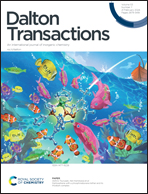Wide-band excited and deep-red sensitized Mn2+ emission from an NaSrSc(BO3)2:Eu2+,Mn2+ phosphor with vanished Eu2+ emission
Abstract
It is of great importance to develop new broadband red phosphors since they have possible applications like plant cultivation, indoor lighting and non-destructive sensing. Herein, we report a series of Eu2+, Mn2+ activated NaSrSc(BO3)2 phosphors via a conventional solid-state reaction route. It has been found that both Mn2+ and Eu2+ solo-doped NaSrSc(BO3)2 show weak or no luminescence, while Eu2+, Mn2+ co-doped NaSrSc(BO3)2 exhibits wide-band absorption and intense deep-red emission at 680 nm with color purity of 89%. Analysis of the absorption, excitation and emission spectra of Eu2+, Mn2+ solo- and co-doped NaSrSc(BO3)2 indicates that this deep-red broadband emission originates from Eu2+ sensitization of the octahedron Mn2+ 4T1–6A1 transition. It was found that the photoionization process led by energetic similarity of the host band-gap and the Eu2+ lowest 5d excited state was mainly responsible for the vanished luminescence of Eu2+. The values of internal quantum efficiency (IQE) and absorption efficiency (AE) for the optimal NSSO:0.007Eu2+,0.05Mn2+ sample are 24.5% and 61.8%, respectively. This work could provide new insights into exploring novel Mn-activated deep-red luminescent materials.



 Please wait while we load your content...
Please wait while we load your content...